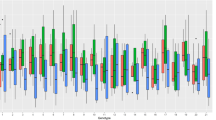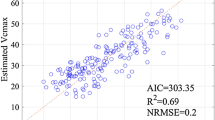Abstract
In-field hyperspectral imagery is a promising tool for crop phenotyping or monitoring. In association with partial least square regression (PLS-R), it allows building high spatial resolution maps of the chemical content of plant leaves. However, several optical phenomena must be taken into account, due to their influence on collected spectral data. The most challenging is multiple scattering, produced when a leaf is partly illuminated by light reflection or transmission from neighboring leaves. It can induce bias in prediction results. This paper presents a method for multi-scattering correction. Its development has been based on simulation tools: a 3D canopy model of winter wheat was combined with light propagation modeling, in order to simulate the apparent reflectance of every visible leaf in the canopy for a given actual reflectance. Leaf nitrogen content (LNC) prediction has been considered. A data set of reflectance spectra associated with LNC values has been issued from real leaf measurements. A theoretical disturbance subspace representing the spectrum dispersion in the spectral space due to multi-scattering has then been built by considering polynomial combinations of the initial spectra, and a projection along this subspace has been applied to every simulated spectra. Using this strategy, a PLS-R model built on initial spectra was still satisfactory when applied to simulated spectra with multiple scattering. The method has then been applied to real plants in greenhouse and field conditions, and its prediction results compared with those of a standard PLS-R, confirming its efficiency in the presence of various lighting environments.























Similar content being viewed by others
Notes
‘.’ is a term by term product where Ri and Ti are integers.
It can be shown that the number of theses vectors is equal to ½.maxD.(maxD + 3).
http://openalea.gforge.inria.fr/dokuwiki/doku.php. Last accessed May 2018.
References
Al Makdessi, N., Jean, P.-A., Ecarnot, M., Gorretta, N., Rabatel, G., & Roumet, P. (2017). How plant structure impacts the biochemical leaf traits assessment from in-field hyperspectral images: A simulation study based on light propagation modeling in 3D virtual wheat scenes. Field Crops Research, 205, 95–105.
Andersson, C. A. (1999). Exploratory multivariate data analysis with applications in food. Chemometrics and Intelligent Laboratory Systems, 47, 189–204.
Chelle, M., & Andrieu, B. (1998). The nested radiosity model for the distribution of light within plant canopies. Ecological Modelling, 111(1), 75–91.
Ecarnot, M., Compan, F., & Roumet, P. (2013). Assessing leaf nitrogen content and leaf mass per unit area of wheat in the field throughout plant cycle with a portable spectrometer. Field Crops Research, 140, 44–50.
Fearn, T. (2000). On orthogonal signal correction. Chemometrics and intelligent laboratory systems, 50(1), 47–52.
Fournier, C., Andrieu, B., Ljutovac, S., & Saint-Jean, S. (2003). ADEL-wheat: A 3D architectural model of wheat development. In B. Hu & M. Jaeger (Eds.), International symposium on plant growth modeling, simulation, visualization, and their applications (pp. 54–63). Beijing, China: Springer.
Hadoux, X., Rutledge, D. N., Rabatel, G., & Roger, J.-M. (2015). DROP-D: dimension reduction by orthogonal projection for discrimination. Chemometrics and Intelligent Laboratory Systems, 146, 221–231.
Hansen, P. W. (2001). Pre-processing method minimizing the need for reference analyses. Journal of Chemometrics, 15(2), 123–131.
Kubelka, P., & Munk, F. (1931). An article on optics of paint layers. Zeitschrift fur Technische Physik, 12, 593–601.
Roger, J.-M., Chauchard, F., & Bellon-Maurel, V. (2003). EPO–PLS external parameter orthogonalisation of PLS application to temperature-independent measurement of sugar content of intact fruits. Chemometrics and Intelligent Laboratory Systems, 66(2), 191–204.
Trygg, J., & Wold, S. (2002). Orthogonal projections to latent structures (O-PLS). Journal of Chemometrics, 16(3), 119–128.
Vigneau, N., Ecarnot, M., Rabatel, G., & Roumet, P. (2011). Potential of field hyperspectral imaging as a non destructive method to assess leaf nitrogen content in Wheat. Field Crops Research, 122(1), 25–31.
Wold, S., Antti, H., Lindgren, F., & Öhman, J. (1998). Orthogonal signal correction of near-infrared spectra. Chemometrics and Intelligent laboratory systems, 44(1–2), 175–185.
Wold, S., Sjöström, M., & Eriksson, L. (2001). PLS-regression: A basic tool of chemometrics. Chemometrics and intelligent laboratory systems, 58(2), 109–130.
Acknowledgements
This study has been supported by Agropolis Foundation under the reference ID 1202-008 through the ‘Investissements d’avenir’ program (Labex Agro:ANR-10-LABX-0001-01), France Agrimer and l’Agence Nationale de la Recherche (ANR) through the Phenoble and Phenome programmes.
Author information
Authors and Affiliations
Corresponding author
Rights and permissions
About this article
Cite this article
Al Makdessi, N., Ecarnot, M., Roumet, P. et al. A spectral correction method for multi-scattering effects in close range hyperspectral imagery of vegetation scenes: application to nitrogen content assessment in wheat. Precision Agric 20, 237–259 (2019). https://doi.org/10.1007/s11119-018-9613-2
Published:
Issue Date:
DOI: https://doi.org/10.1007/s11119-018-9613-2




